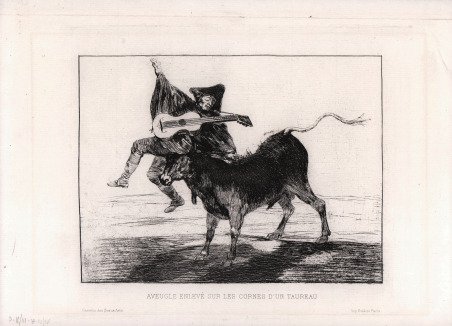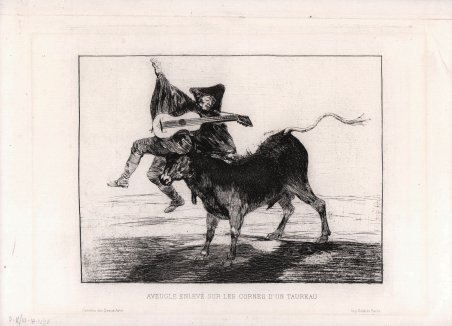Uomo cieco con chitarra sulle corna di un toro; prima edizione, pubblicata nella Gazette des Beaux Arts del 1867. Conosciuta anche con i titoli di Che Dio ti ripaghi e Divertimento barbaro. Acquaforte, acquatinta e puntasecca con leggera tonalità superficiale, prima del 1804, incisa sulla lastra con il titolo "AVEUGLE ENLEVÉ SUR LES CORNES D'UN TAUREAU" e gli estremi di pubblicazione Gazette des Beaux Arts (angolo inferiore sinistro) e Imp. Delâtre Paris (angolo inferiore destro). L'acquaforte mostra un toro che carica un uomo cieco, vestito con mantello e cappello e con una chitarra in mano. In questa immagine non ci sono riferimenti spaziali per identificare il luogo in cui si svolge la scena. Il cieco assomiglia molto alla figura de Il chitarrista cieco di Goya, ed è vestito allo stesso modo. Ciò può far pensare che potessero esistere altre incisioni di questo stesso personaggio, o che forse Goya avesse in mente di realizzarne altre, per rappresentare altri episodi della vita del cieco. Più tardi, durante il suo soggiorno a Bordeaux, Goya tornò sul tema della cecità nell'opera Il cantante cieco. Si pensa che questa incisione sia stata realizzata prima del 1804, poiché esisteva già una copia nella collezione di Giovanni Domenico Tiepolo (Venezia, 1727-Venezia, 1804) al momento della sua morte, avvenuta nello stesso anno. Il titolo di Che Dio ti ripaghi deriva dall'annotazione manoscritta di Goya sul disegno preparatorio. Il titolo di Divertimento barbaro è stato tratto dalla nota scritta sulla prova di stampa che accompagnava la prima edizione della serie della Tauromachia appartenuta a Ceán Bermúdez e oggi conservata al British Museum di Londra. Un disegno preparatorio per questa incisione si trova al Museo del Prado. Bellissima impressione su carta vergata coeva, con margini, in buono stato di conservazione. Bibliografia Harris 1964, Goya: Engravings and Lithographs (25.III/IV); Delteil, Le Peintre-Graveur Illustré (XIXe et XXe siècles) n. 24 II/III; Gassier, Pierre y Wilson, Juliet, Vie et ouvre de Francisco de Goya, 1970, cat. 772; Santiago, Elena, Catálogo de las estampas de Goya en la Biblioteca Nacional, 1996, cat. 66. Etching, aquatint and drypoint with light surface tone, before 1804, lettered on plate with title "AVEUGLE ENLEVÉ SUR LES CORNES D'UN TAUREAU" and publication detail Gazette des Beaux Arts (lower left-hand corner) and Imp. Delâtre Paris (lower right-hand corner). This etching shows a bull as it charges at a blind man, dressed in a cape and hat and holding a guitar. There are no spatial references in this image to identify where the scene is taking place. The blind man bears a striking resemblance to the figure in The Blind Guitarist and is also dressed the same. This may suggest that there could have existed more etchings of this same character, or that perhaps Goya had planned to make more, in order to depict further episodes from the blind man's life. Later, during his stay in Bordeaux, Goya returned to the topic of blindness in the work The Blind Singer. This etching is thought to have been made prior to 1804, since there already existed a copy in the collection of Giovanni Domenico Tiepolo (Venice, 1727-Venice, 1804) at the time of his death that same year. The title of May God repay you comes from the handwritten note made by Goya on the preparatory drawing. The title of Barbarous Entertainment has been taken from the note written on the proof which was included with the first edition copy of the Bullfighting (Tauromaquia) series which belonged to Ceán Bermúdez and which is now in the British Museum, London. There is a preparatory drawing for this etching in the Prado Museum. Bibliografia Harris 1964, Goya: Engravings and Lithographs (25.III/IV); Delteil, Le Peintre-Graveur Illustré (XIXe et XXe siècles) n. 24 II/III; Gassier, Pierre y Wilson, Juliet, Vie et ouvre de Francisco de Goya, 1970, cat. 772; Santiago, Elena, Catálogo de las estampas de Goya en la Biblioteca Nacional, 1996, cat. 66. Cfr.


Scopri come utilizzare
Scopri come utilizzare

